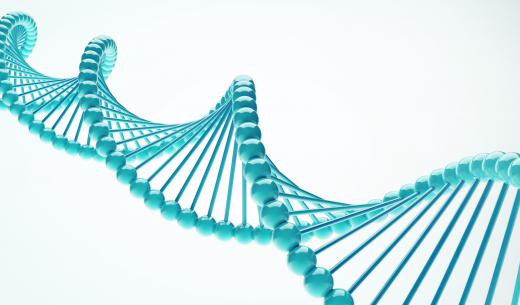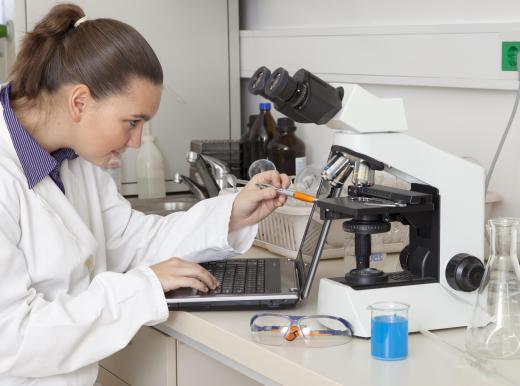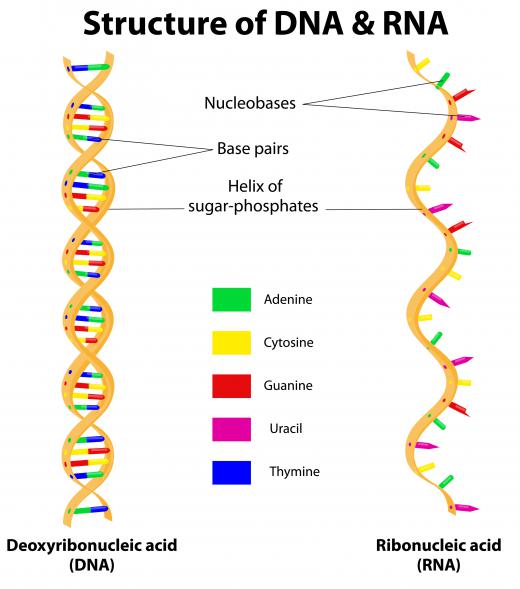What is a Bacterial Plasmid?
 Mary McMahon
Mary McMahon
A bacterial plasmid is a strand of DNA inside a bacterium which is independent of the bacterium's chromosomal DNA. Plasmids are capable of replicating on their own, and they can be passed between organisms, an important trait for bacteria, as they use plasmids to transfer genetic information between each other. This ability also becomes important for researchers, who use bacterial plasmids as vectors to insert foreign DNA into DNA they are researching.
The structure of a plasmid is often double stranded and circular. It can contain a varying length of genetic information, and there are several different kinds of plasmids which can perform different functions. Some, for example, can perform conjugation, connecting with another bacterium to transfer genetic information. Others carry genetic information which confers antibiotic resistance, helps a bacterium break down nutrients to make them accessible, or makes the bacterium virulent. These plasmids cannot conjugate on their own; they need help from a conjugating plasmid.

Gene transfer between bacteria via a bacterial plasmid is a fascinating technique which allows these organisms to transfer genetic material horizontally, rather than being limited to passing it between generations. This is one of the reasons bacteria have been able to thrive for so long, because they can adapt to their environments extremely quickly. For example, if an antibiotic is introduced, bacteria with plasmids which help them resist that antibiotic can pass those plasmids on to other bacteria.

Genetic researchers take advantage of the plasmid as an ideal vector for carrying DNA for research purposes. They use a conjugating plasmid which is designed to transfer genetic material, and insert the DNA of their choice into the plasmid so that it will be transferred. Then, they introduce the bacterial plasmid to a cell culture, allowing the cells to become infected, so to speak, with the new genetic material, which will then be reproduced when the cells divide.

Thanks to the widespread use of plasmids in genetic research, a number of labs are capable of generating plasmids for research by request. Scientists can order a bacterial plasmid from one of these labs, and the lab will insert the target DNA and package the bacterial plasmid for use. In other cases, researchers may prefer to prepare their own plasmids for research, for a variety of reasons ranging from a desire to control the conditions of the experiment to concerns about the security of the DNA they are researching.
AS FEATURED ON:
AS FEATURED ON:













Discussion Comments
@babiesX3 - I'm no researcher, but I would assume it would probably have something to do with DNA cloning. I imagine that bacteria cells, like most cells, have different structures so placing the bacterial plasmid dna that they want to research into uniform cells would create, well, uniform samples to work with. Of course, I could be wrong and I am sure it's a good bit more complex than that, but this is what makes sense to me.
Well I never knew that bacteria had plasmid DNA. I'm not sure what I thought they used to reproduce, but that certainly wan't on my list of possibilities.
What I don't understand is why researchers would take the plasmid out of one bacteria and put it into another. I mean, I get the whole thing about wanting to control the environment and all. I just don't understand why they would need to extract the dna from one bacteria and transplant it in order to achieve that.
Isn't the plasmid what makes the bacteria different from one another in the first place? Would you not essentially be recreating the same bacteria you extracted the plasma from by injecting it into another?
So that's how those little buggers work up a resistance to antibiotics! Wow. Plasmid bacteria...would have never guess that one. I think it's really awesome, and just a bit unnerving, that they can pass this information from one cell to another without the typical "evolution" process. No wonder we keep having to come up with new medications to treat infections.
Post your comments